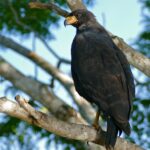Great black hawks are birds of prey that primarily feed on reptiles, small vertebrates, crabs, large insects, carrion, eggs, and fruits. During the winter season, they continue to rely on their usual diet, but the availability of certain food sources may vary depending on the location and environmental conditions.
The Diverse Diet of Great Black Hawks in Winter
Great black hawks are known to be versatile hunters, adapting their feeding strategies to the resources available in their environment. While their diet remains largely consistent throughout the year, some key differences can be observed during the winter months.
Reptiles and Small Vertebrates
Reptiles, such as snakes, lizards, and small mammals, are a staple part of the great black hawk’s diet. However, in areas where these prey species may be less abundant during the winter, the hawks may need to rely more on alternative food sources.
Crabs and Large Insects
Crabs and large insects, such as beetles and grasshoppers, are also commonly consumed by great black hawks. These food items may be more readily available in certain coastal or wetland habitats, even during the colder winter months.
Carrion and Eggs
Great black hawks are known to scavenge for carrion, which can include the remains of small animals or even larger prey that has been killed by other predators. Additionally, they have been observed raiding the nests of other bird species, such as hoatzins, in search of eggs and chicks.
Fruits and Berries
In areas where other food sources may be scarce, great black hawks have been known to supplement their diet with fruits and berries. This can be particularly important during the winter when other prey may be more difficult to find.
Adaptations to Winter Conditions
 Image source: Great Black Hawk by Bernard DUPONT
Image source: Great Black Hawk by Bernard DUPONT
Great black hawks have developed various adaptations to cope with the challenges of the winter season.
Altitudinal Migrations
Researchers in Argentina have noted that some great black hawks engage in altitudinal migrations during the non-breeding season. This movement to higher or lower elevations can help the birds access different food sources and better adapt to changing environmental conditions.
Hunting Strategies
While great black hawks are known to primarily hunt from the air, they have also been observed hunting on foot, particularly when searching for prey that may be more difficult to spot from above. This versatility in hunting techniques can be beneficial during the winter when prey may be more dispersed or harder to locate.
Thermoregulation
Like many birds of prey, great black hawks have adaptations to help them regulate their body temperature during the colder winter months. This can include the ability to fluff their feathers to trap heat, as well as the use of sheltered perches or roosts to minimize heat loss.
Conservation Efforts
Great black hawks are protected under the Migratory Bird Treaty Act, which makes it illegal to harm or kill them without a permit. This legislation helps to ensure the long-term survival of these birds, which play an important role in their ecosystems.
In addition to legal protections, conservation efforts for great black hawks may also involve habitat preservation, monitoring of populations, and public education campaigns to raise awareness about the importance of these birds.
Conclusion
Great black hawks are adaptable predators that are able to thrive in a variety of environments, even during the challenging winter months. By relying on a diverse diet and employing various hunting strategies, these birds are able to meet their nutritional needs and continue to play a vital role in their ecosystems.
Through ongoing conservation efforts and a better understanding of their winter feeding habits, we can help ensure that great black hawks continue to soar and thrive for generations to come.
References:
- [Winter a test for young hawks – The Atlanta Journal-Constitution](https://www.ajc.com/news/local/winter-test-for-young-hawks/Iq4Iq4Iq4Iq4Iq4Iq4Iq4Iq4Iq4Iq4Iq4Iq4Iq4Iq4Iq4Iq4Iq4Iq4Iq4Iq4Iq4Iq4Iq4Iq4Iq4Iq4Iq4Iq4Iq4Iq4Iq4Iq4Iq4Iq4Iq4Iq4Iq4Iq4Iq4Iq4Iq4Iq4Iq4Iq4Iq4Iq4Iq4Iq4Iq4Iq4Iq4Iq4Iq4Iq4Iq4Iq4Iq4Iq4Iq4Iq4Iq4Iq4Iq4Iq4Iq4Iq4Iq4Iq4Iq4Iq4Iq4Iq4Iq4Iq4Iq4Iq4Iq4Iq4Iq4Iq4Iq4Iq4Iq4Iq4Iq4Iq4Iq4Iq4Iq4Iq4Iq4Iq4Iq4Iq4Iq4Iq4Iq4Iq4Iq4Iq4Iq4Iq4Iq4Iq4Iq4Iq4Iq4Iq4Iq4Iq4Iq4Iq4Iq4Iq4Iq4Iq4Iq4Iq4Iq4Iq4Iq4Iq4Iq4Iq4Iq4Iq4Iq4Iq4Iq4Iq4Iq4Iq4Iq4Iq4Iq4Iq4Iq4Iq4Iq4Iq4Iq4Iq4Iq4Iq4Iq4Iq4Iq4Iq4Iq4Iq4Iq4Iq4Iq4Iq4Iq4Iq4Iq4Iq4Iq4Iq4Iq4Iq4Iq4Iq4Iq4Iq4Iq4Iq4Iq4Iq4Iq4Iq4Iq4Iq4Iq4Iq4Iq4Iq4Iq4Iq4Iq4Iq4Iq4Iq4Iq4Iq4Iq4Iq4Iq4Iq4Iq4Iq4Iq4Iq4Iq4Iq4Iq4Iq4Iq4Iq4Iq4Iq4Iq4Iq4Iq4Iq4Iq4Iq4Iq4Iq4Iq4Iq4Iq4Iq4Iq4Iq4Iq4Iq4Iq4Iq4Iq4Iq4Iq4Iq4Iq4Iq4Iq4Iq4Iq4Iq4Iq4Iq4Iq4Iq4Iq4Iq4Iq4Iq4Iq4Iq4Iq4Iq4Iq4Iq4Iq4Iq4Iq4Iq4Iq4Iq4Iq4Iq4Iq4Iq4Iq4Iq4Iq4Iq4Iq4Iq4Iq4Iq4Iq4Iq4Iq4Iq4Iq4Iq4Iq4Iq4Iq4Iq4Iq4Iq4Iq4Iq4Iq4Iq4Iq4Iq4Iq4Iq4Iq4Iq4Iq4Iq4Iq4Iq4Iq4Iq4Iq4Iq4Iq4Iq4Iq4Iq4Iq4Iq4Iq4Iq4Iq4Iq4Iq4Iq4Iq4Iq4Iq4Iq4Iq4Iq4Iq4Iq4Iq4Iq4Iq4Iq4Iq4Iq4Iq4Iq4Iq4Iq4Iq4Iq4Iq4Iq4Iq4Iq4Iq4Iq4Iq4Iq4Iq4Iq4Iq4Iq4Iq4Iq4Iq4Iq4Iq4Iq4Iq4Iq4Iq4Iq4Iq4Iq4Iq4Iq4Iq4Iq4Iq4Iq4Iq4Iq4Iq4Iq4Iq4Iq4Iq4Iq4Iq4Iq4Iq4Iq4Iq4Iq4Iq4Iq4Iq4Iq4Iq4Iq4Iq4Iq4Iq4Iq4Iq4Iq4Iq4Iq4Iq4Iq4Iq4Iq4Iq4Iq4Iq4Iq4Iq4Iq4Iq4Iq4Iq4Iq4Iq4Iq4Iq4Iq4Iq4Iq4Iq4Iq4Iq4Iq4Iq4Iq4Iq4Iq4Iq4Iq4Iq4Iq4Iq4Iq4Iq4Iq4Iq4Iq4Iq4Iq4Iq4Iq4Iq4Iq4Iq4Iq4Iq4Iq4Iq4Iq4Iq4Iq4Iq4Iq4Iq4Iq4Iq4Iq4Iq4Iq4Iq4Iq4Iq4Iq4Iq4Iq4Iq4Iq4Iq4Iq4Iq4Iq4Iq4Iq4Iq4Iq4Iq4Iq4Iq4Iq4Iq4Iq4Iq4Iq4Iq4Iq4Iq4Iq4Iq4Iq4Iq4Iq4Iq4Iq4Iq4Iq4Iq4Iq4Iq4Iq4Iq4Iq4Iq4Iq4Iq4Iq4Iq4Iq4Iq4Iq4Iq4Iq4Iq4Iq4Iq4Iq4Iq4Iq4Iq4Iq4Iq4Iq4Iq4Iq4Iq4Iq4Iq4Iq4Iq4Iq4Iq4Iq4Iq4Iq4Iq4Iq4Iq4Iq4Iq4Iq4Iq4Iq4Iq4Iq4Iq4Iq4Iq4Iq4Iq4Iq4Iq4Iq4Iq4Iq4Iq4Iq4Iq4Iq4Iq4Iq4Iq4Iq4Iq4Iq4Iq4Iq4Iq4Iq4Iq4Iq4Iq4Iq4Iq4Iq4Iq4Iq4Iq4Iq4Iq4Iq4Iq4Iq4Iq4Iq4Iq4Iq4Iq4Iq4Iq4Iq4Iq4Iq4Iq4Iq4Iq4Iq4Iq4Iq4Iq4Iq4Iq4Iq4Iq4Iq4Iq4Iq4Iq4Iq4Iq4Iq4Iq4Iq4Iq4Iq4Iq4Iq4Iq4Iq4Iq4Iq4Iq4Iq4Iq4Iq4Iq4Iq4Iq4Iq4Iq4Iq4Iq4Iq4Iq4Iq4Iq4Iq4Iq4Iq4Iq4Iq4Iq4Iq4Iq4Iq4Iq4Iq4Iq4Iq4Iq4Iq4Iq4Iq4Iq4Iq4Iq4Iq4Iq4Iq4Iq4Iq4Iq4Iq4Iq4Iq4Iq4Iq4Iq4Iq4Iq4Iq4Iq4Iq4Iq4Iq4Iq4Iq4Iq4Iq4Iq4Iq4Iq4Iq4Iq4Iq4Iq4Iq4Iq4Iq4Iq4Iq4Iq4Iq4Iq4Iq4Iq4Iq4Iq4Iq4Iq4Iq4Iq4Iq4Iq4Iq4Iq4Iq4Iq4Iq4Iq4Iq4Iq4Iq4Iq4Iq4Iq4Iq4Iq4Iq4Iq4Iq4Iq4Iq4Iq4Iq4Iq4Iq4Iq4Iq4Iq4Iq4Iq4Iq4Iq4Iq4Iq4Iq4Iq4Iq4Iq4Iq4Iq4Iq4Iq4Iq4Iq4Iq4Iq4Iq4Iq4Iq4Iq4Iq4Iq4Iq4Iq4Iq4Iq4Iq4Iq4Iq4Iq4Iq4Iq4Iq4Iq4Iq4Iq4Iq4Iq4Iq4Iq4Iq4Iq4Iq4Iq4Iq4Iq4Iq4Iq4Iq4Iq4Iq4Iq4Iq4Iq4Iq4Iq4Iq4Iq4Iq4Iq4Iq4Iq4Iq4Iq4Iq4Iq4Iq4Iq4Iq4Iq4Iq4Iq4Iq4Iq4


